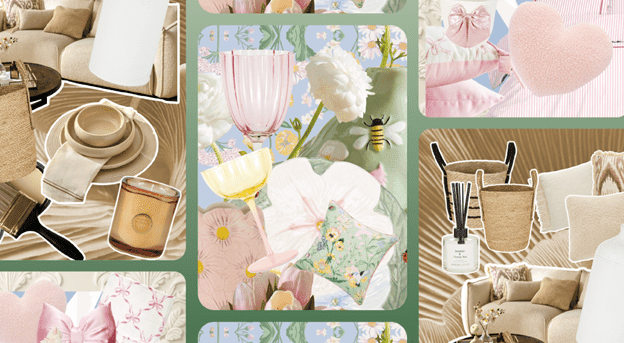Are consumers stuck in an endless cycle of ‘aesthetic’ dupes?
The homeware market is now mirroring the fast fashion industry, where businesses prioritise short-term trends over long-term design ideas

Register to get 1 free article
Reveal the article below by registering for our email newsletter.
Want unlimited access? View Plans
Already have an account? Sign in
The retail landscape is increasingly defined by a relentless cycle of “aesthetic” dupes – fast, trend-driven products designed to mimic high-end styles at a fraction of the cost. From Pinterest and Primark’s new trend-inspired collection to Temu’s staggering 77% product overlap with Amazon – where every tenth item is identical, according to a new study by Omnisend – copycat culture is thriving.
Pinterest and Primark’s collaboration has embraced this aesthetic-driven shopping culture with a collection inspired by the social media platform’s most popular home trends: minamaluxe, cosy cottage, and dainty décor. By aligning its offering with real-time search data, Primark aims to give consumers “instant access to the latest styles – at ultra-low prices”. While these hyper-affordable alternatives promise accessibility, they also raise pressing concerns for retailers. Are brands inadvertently training consumers to expect endless replication rather than uniqueness? Worse still, are these trends fuelling a disposable mindset at a time when sustainability expectations should be rising?
To make these trends even more accessible, Primark has expanded its click-and-collect model, which allows customers to browse Pinterest-curated designs and purchase them in-store with little effort. In turn, Pinterest has integrated virtual shopping tools and AI-powered recommendations to further reinforce this cycle of rapid consumption.
According to Albert Varkki, fashion retail expert and co-founder of Von Baer, the homeware market is now mirroring the fast fashion market, where businesses prioritise short-term trends over long-term design ideas. “Most companies make trend-inspired duplicates instead of creating unique designs through the application of data-backed consumer insights on websites such as Pinterest and TikTok, instead of fostering genuine creativity,” he said.
If Primark has perfected the art of trend-driven affordability, Temu has taken it a step further into the realm of mass replication.
The emergence of social media platforms as trend incubators has played a significant role in fuelling this cycle. Consumers are no longer just browsing traditional showrooms for inspiration – they are constantly exposed to algorithm-driven décor trends that shift with each season. What was once a long-term investment – furniture and home furnishings – is now treated as a disposable fashion statement.
If Primark has perfected the art of trend-driven affordability, Temu has taken it a step further into the realm of mass replication. Omnisend recently reported that 77% of Temu’s products match items already listed on Amazon, with many being near-identical copies. Besides this copy-cat behaviour, the platform has built its business model around extreme price competition, and has flooded the market with inexpensive dupes of everything from electronics to home goods.
Ecommerce expert at Omnisend, Greg Zakowicz, believes that Temu’s way of operating is shifting consumer expectations on what everyday products should cost, which in turn puts pressure on competitors to adapt. “Value-minded shopping has been a staple of consumers over the past year-plus, and with economic uncertainty hanging over 2025, I expect this to continue,” he said. “For most ecommerce businesses, competing on price with large brands and discount-heavy marketplaces isn’t viable. Ecommerce businesses that want to grow despite economic headwinds will need to find ways to compete in other ways.”
This accessibility raises pressing questions: what are the hidden costs of this affordability, and who is paying the price for our rapidly-shifting preferences? The answer, as experts suggest, lies in environmental degradation, exploitative labour, and a culture of waste. The speed at which new homeware trends emerge means that millions of cheaply made, mass-produced items are discarded almost as quickly as they are purchased. Unlike durable furniture made out of higher quality materials, many of these affordable pieces have short lifespans by design. Unsurprisingly, this leads to mounting waste and consequences for the environment.
The industry doesn’t want consumers to think long-term, so cheap, trend-led furniture is designed to fail.
“We hear it all the time: customers telling us that the cheap furniture they bought online looked great in pictures but barely lasted a few weeks before falling apart,” Ben Simpson, founder of his eponymous furniture company, said. “The rise of specific, never-ending social media-driven homeware trends is fuelling a throwaway culture for sure. It’s great for profits, but terrible for the planet.”
Many of these items are produced using low-quality particleboard, synthetic fabrics, and non-recyclable plastics – materials that degrade quickly and are difficult, if not impossible, to repurpose. Beyond the environmental impact, many of these products are manufactured in factories with poor labour conditions and unfair wages, similar to the concerns raised within the fast fashion industry.
Simpson pointed out the structural nature of this problem, where companies prioritise their profit margins over sustainability targets, saying: “The industry doesn’t want consumers to think long-term, so cheap, trend-led furniture is designed to fail.” He is of the opinion that if consumers remain unaware of these practices – or simply choose affordability over ethics – this cycle will be unlikely to change.
For many consumers, budget-friendly homeware is seen as an essential alternative to high-end pieces. After all, not everyone can afford handcrafted, artisanal furniture. However, as Simpson shared, the idea that quality homeware is financially out of reach is a carefully cultivated myth – one that benefits mass-market retailers while keeping customers locked in a cycle of continuous replacement purchases. He said: “The idea that quality furniture is unaffordable is a myth, and one that fast homeware brands want to keep alive. That’s exactly why we launched our lifetime guarantee on all Ben Simpson furniture items, proving that well-made homeware doesn’t have to cost the earth (literally or financially).”
Companies like Ben Simpson Furniture, which are offering lifetime guarantees on affordable furniture, are proving that stylish and sustainable homeware doesn’t have to be expensive.
While affordability is the primary draw of aesthetic dupes, there are signs that consumers are becoming more aware of the hidden costs of buying cheap. According to the latest research from Aquapak, 65% of UK consumers believe that retailers aren’t doing enough to reduce plastic packaging – and nearly half say they will stop buying products with excessive plastic waste in the next three years.
For brands, the most effective way forward is to prioritise quality, longevity, and sustainability over quantity and trend chasing. This shift can be seen in retailers who are experimenting with circular economy models, durable materials and repair initiatives to offer consumers an alternative to today’s throwaway culture. Companies like Ben Simpson Furniture, which are offering lifetime guarantees on affordable furniture, as well as other retailers that are actually using reclaimed and recycled materials (not just saying so), are proving that stylish and sustainable homeware doesn’t have to be expensive.
Speaking of recycled and reclaimed materials, it has to be genuine; vague buzzwords like “responsibly sourced” and “eco-friendly” have become so commonplace that they have lost all meaning. At best, it lacks transparency. At worst, it’s covering up some major faults within the supply chain. As consumers grow more conscious of environmental issues, there is a growing demand for genuine transparency.
The rise of aesthetic dupes in homeware mirrors fast fashion’s wasteful cycle. Affordability drives demand, but the hidden costs – environmental harm and exploitation – are mounting. Brands must shift focus from cheap, trend-driven replication to durable, sustainable design. In turn, consumers must continue to demand transparency and value over novelty. The path forward should be paved with sustainability, quality and ethics. However, if the industry chooses to not replace disposability, the illusion of affordable style will eventually collapse, leaving a heap of waste in its wake.







